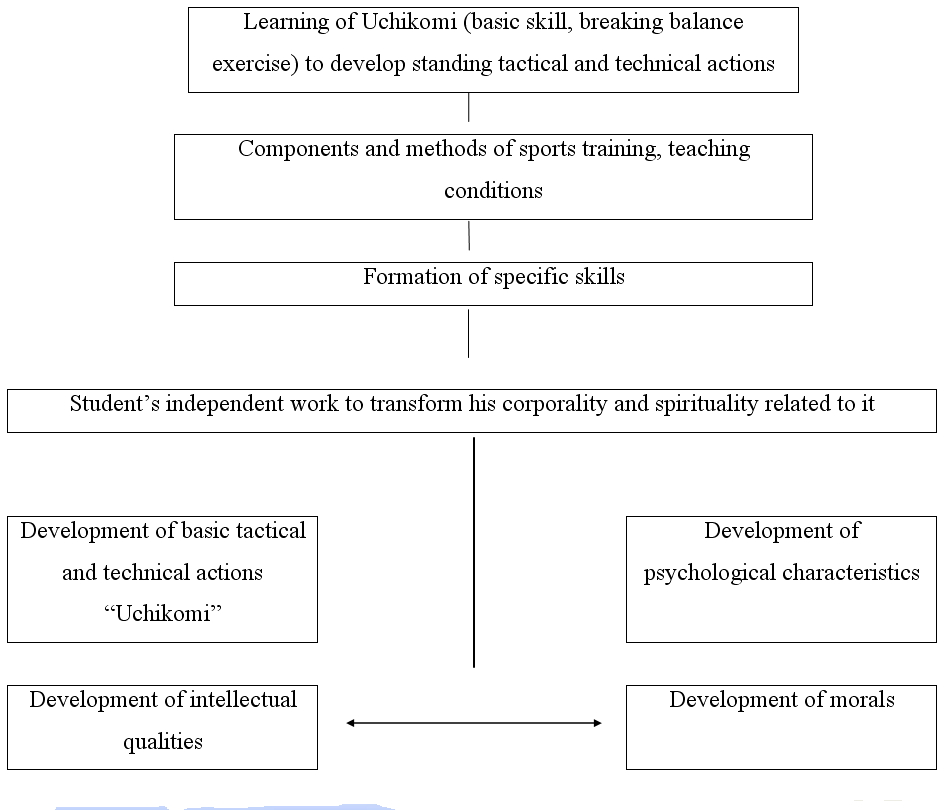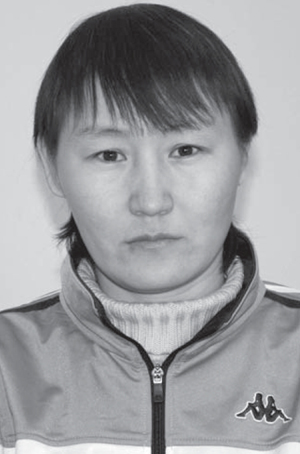MODELING OF TECHNICAL-TACTICAL SKILLS OF STUDENTS-JUDOKAS IN UNIVERSITY CONDITIONS
Фотографии:
ˑ:
M.P. Danilova
V.G. Torgovkin, associate professor, Ph.D.
Institute of physical culture and sport of North-Eastern federal university named after M.K. Ammosov, Yakutsk
Key words: combat sports, technical skills, tactics, self-improvement, education.
Relevance of research. Judo can be mastered in case of following the principle of peak effect at maximum effort and trainers should remind students about it [1]. Thus, the empiric solution of training issues apart from the pedagogical and biomechanical data results in blind experiments with athletes, which is inadmissible and dangerous for health within modern student sport with its vast intellectual and physical loads. In view of the quoted circumstance every practical class on the department of combat sports of Institute of physical culture and sport is held under the observation of teaching trainers in collaboration with doctors of the educative-training center of North-Eastern federal university with the use of modern teaching technologies.
The purpose of the study was to design the models of development of tactics and technical skills of students-judokas.
Materials and methods. The research methods included literature analysis and synthesis of advanced practical training experience, pedagogical observation, pedagogical experiment, trainers’ questionnaire and interview, analysis of leading athletes' technique based on video records, pedagogical test and anthropometrical measurements.
Improvement of the system of tactical and technical actions of students-judokas is marked to contain didactic aspects of teaching young judokas throwing technique.
The pedagogical experiment was based on the North-Eastern federal university named after M.K. Ammosov with 17 students, 10 athletes of the nearest degree and 2 trainers involved in it.
The respondents were in the transition period from the junior to senior age and had specific morphofunctional and mental characteristics. In this age one should be careful when encouraging and punishing, determining winners in martial arts and games, specifically with freshmen during the 1st semester, when students are adapting to university conditions.
The model of formation of tactical and technical actions of students-judokas represents realization of conceptual components and means of sports training, pedagogical conditions, without which one cannot master complex technical fighting movements, and it clarifies the necessity of the training process focused on formation of specific skills. Herewith, it should be noted that freshmen (juniors) are the first to have the symptoms of fatigue, along with attention deficit, young boys and girls are more responsive to various irritants, but still can work enough to improve the abovementioned qualities (Diagram).

The model of individual improvement of tactical and technical movements of students-judokas
While mastering technique in the structure of movements faults occur due to numerous reasons and are consolidated, preventing the full use of the existing motor potential in the future. All the faults arise in the very beginning of studies. It is notable that the main faults are traced on all levels of sportsmanship, i.e. having been acquired in the beginning they are subsequently consolidated in a motor skill. The tiniest technical faults transformed into skills affect the structure of throw performance in more complex conditions, since the formed nervous connections are not destroyed but participate in further inhibitory processes and can show up again. Imperfect technique inhibits sports progress that is why students-wrestlers should be taught the efficient basic technique relevant to their individual characteristics.
The first thing wrestlers should learn in the long-term training system is Uchikomi - the Japanese word for the repeated practice of forced throwing movement. This way of learning judo technique starting from “Uchikomi” performance promotes quicker and more effective development of motor skills (learning and execution of throws). In other words, Uchikomi is a constituent of the majority of standing throwing techniques, especially forward ones (lifting pulling hip – Tsurikomi Goshi, two-arm shoulder throw – Morote Seoinage, body drop – Tai Otoshi, swipping hip throw – Harai Goshi, major inner reaping, inside trip – Ouchi Gari) [1, 2].
The issue of execution of the technique of the basic move Uchikomi is insufficiently covered in the specialized literature.
The content of technical and tactical preparedness of judokas was determined by analyzing of video records trainers and athletes’ parents from the competitions (Yakutsk championships, children’s and youth sports school № 2, RS (Y), municipal tournaments). 80 contest fights were subject to analysis.
Results and discussion. The analysis of the athletes’ competitive activity revealed a range of judo throwing techniques (Table).
Table.
|
Throws applied |
Juniors |
|
Hold |
1 |
|
Hip roll |
2 |
|
Large inner reap |
4 |
|
Outside leg trip |
5 |
|
Rear throw |
7 |
|
Forward foot sweep |
9 |
|
Minor inner reap |
10 |
|
Minor outer reap |
11 |
|
Minor inner hook |
12 |
|
Minor outer hook |
13 |
|
Advanced foot sweep |
16 |
|
Circular throw |
17 |
|
Side drop |
18 |
|
Breaking balance |
19 |
|
Spring hip throw |
20 |
The content and order of learning of basic judo techniques were determined by comparing the research results with the use of the method based on applicability and efficiency of techniques.
15 trainers of the Republic of Sakha (Yakutia) were quizzed on learning of judo technique in groups of beginners with the following questions:
1. Do you start teaching technique from mat or standing practice in the group of beginners of the first year of study?
2. What movement or throw do you start with when learning judo technique during standing practice?
As shown by the quiz, most of the trainers start teaching from mat technique (everybody starts from learning of holds) due to the supposed risk of injury during standing practice while falling stipulated by the variety of fitness levels and motor skills of beginning judokas. In mat techniques the risk of injury is smaller due to the lack of falls from height. Furthermore, the majority of trainers were revealed to start teaching standing techniques from body throws (hip roll, advanced foot sweep, back carry throw, outside leg trip). It should be mentioned that very few trainers keep to “Asian judo school”, due to the origin of tutors of our trainers who have come mostly from sambo wrestling, and many trainers admit the influence of the “tutors” on their work.
Three trainers out of all respondents start teaching judo standing technique from “Uchikomi”, two trainers - from breaking balance which is very close to Uchikomi, two other trainers suggest learning judo standing technique straight on the move, which promotes development of coordination skills of young judokas. At the initial stage much attention is paid to holding technique. Eight trainers teach standing throwing technique starting from such popular throws as outside leg trip, hip roll, advanced foot sweep, minor inner hook etc.
Later on some trainers come to “Uchikomi” practice. Most of the video courseware on judo technique is based on mastering and ability to execute the basic movement Uchikomi.
Proceeding from the results of the quiz, every judo trainer regardless of his experience and education or courseware has his own model pattern of learning of judo technique. The analysis of practices of the technique of performance of basic movements among young judokas testified to poor knowledge of basic techniques and weak skill drilling. Based on the above, a unified program (recommendations) on learning of techniques is to be worked for trainers of the Republic of Sakha (Yakutia).
Thus, while designing the model of tactical and technical actions of students-judokas special attention is to be paid to the individually worked model of learning of judo technique, always provoking high results in performance in big competitions.
References
- Harrington, P. Judo: A pictorial manual / P. Harrington / Transl. from Engl. by E. Kupalo. – Moscow: FAIR-PRESS, 2003. – 400 P. (In Russian)
- Yamashita, Ya. The fighting spirit of judo: Unique master’s technique / Ya. Yamashita / Transl. from Engl. by E. Kupalo. – Moscow: FAIR-PRESS, 2004. – 192 P. (In Russian)
Author’s contacts:
M.P. Danilova: mob.ph.: 89246630417. E-mail: treinerjudo@mail.ru
V.G. Torgovkin: mob.ph.: 89142217562 E-mail: torgovkinvg@mail.ru


